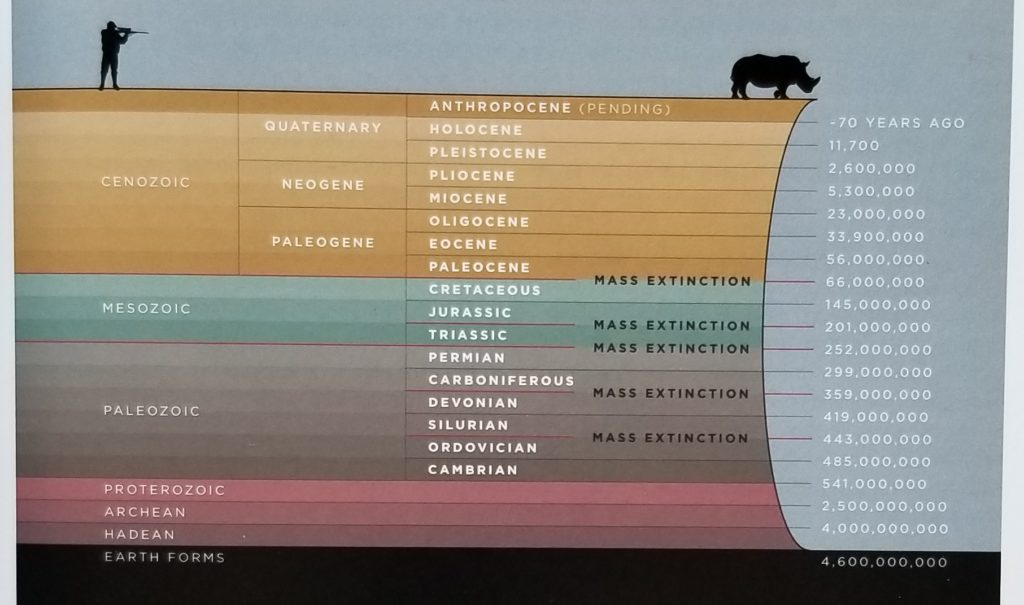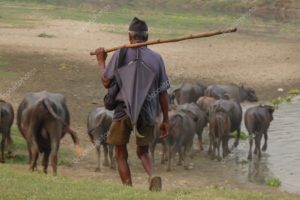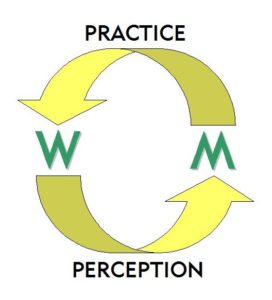Merleau-Ponty speaks of perception as the ‘coition, so to speak, of our body with things’. The phrase ‘so to speak’ marks this as a metaphor, but there’s more here than superficial wordplay: in English the idea of coition is linked to verbal as well as sexual ‘communication’ because we can use intercourse as a synonym for either one. The link between communication and communion is even more obvious. There is also a link between knowing and coition in the English of the King James Bible – ‘And Adam knew his wife…’ – which link is also implicit in the original Hebrew (Scholem 1946, 235). Likewise the reader’s intercourse with the sacred text can generate enlightenment, and the conversation with nature as scientific inquiry can lead us toward the truth about the universe. But as Charles Peirce observed, the problem of finding a sound method of inquiry can be difficult. In a 1906 essay, he used the metaphor of the two sexes and their intercourse to explain the Aristotelian concept of growth as a fruitful key to this problem:
The idea of growth,— the stately tree springing from the tiny grain,— was the key that Aristotle brought to be tried upon this intricate grim lock. In such trials he came upon those wonderful conceptions, δύναμις and ἐνέργεια, ὕλη and μορφή or εἶδος, or, as he might still better have said, τύπος, the blow, the coup.
The terms δύναμις and ἐνέργεια are typically translated as “potentiality” and “actuality” respectively; ὕλη is the term for matter, μορφή and εἶδος terms for form, in this distinction between two kinds of beings (which was basic to Aristotle’s ontology). But why does Peirce suggest that ‘τύπος, the blow, the coup’ might be a better term for the form side of this duality? The history of the word (including the English word “type”) is outlined in this 2018 blog post; but the Peirce essay quoted here uses the metaphor of sexuality to explain how τύπος is related to the key concept of ‘growth.’
Peirce does not mention here the Aristotelian term which he is translating as ‘Growth’, but probably it would be ἐντελέχεια, entelechy, meaning something like “full realization of potential.” This is an organic kind of growth, not merely increase in size or amount of anything. Peirce refers to it as ‘perfecting growth’ in his further development of the idea:
Let us lose sight of no side of it; Growth,—the idea,— the act,— the lifegiving principle.
One special feature of growth has always received great attention; yet its lessons are far from having today been completely learned. It is that growth cannot proceed very far until those elements of it which constitute the functions of the two sexes get well separated. The female function, the function of the seed, has always been recognized as the δύναμις. The female is the general and essential sex; the male merely executes a hunch, the τύπος of the μορφή. It is the principle of unrest. But do not forget that the seed needs to be left to itself to grow as far as it can alone, before the coup of fertilization disturbs it. In order that it could so have grown alone, and indeed, in low organisms have reached the height of their attained potentiality, the female must have had an admixture of the restless. Pure femininity is not to be found even in the nucleus of the crystal of alum quietly growing out of its evaporating solution. Pure femininity can be conceived in a general way, but it cannot be realized even in consistent imagination. As for pure masculinity, it is an absurdity and nonsense, vox et praeterea nihil.
Besides those two requisites of perfecting growth, there is a third, not implied in either of them, nor in both together. It is the congress of those two. It is something demonstrably additional to them. When this comes a new life begins.
Now apply these ideas to knowledge. Observe that this will itself [be] an act of copulation. There is nothing in the feminine conception of knowledge, nor in the masculine conception of sexuality, to prove that there will be any fruit for philosophy in bringing them together. An incomprehensible instinct urges us to it; nothing else.
The seed of knowledge is the mind, the field of available consciousness,— all that is present or that can be called up. The rude τύπος is experience. He who may not have felt quite sure of understanding why the entrance of the element of Form should be called [experience] will find enlightenment in thinking of the matter from this point of view.
To retrace Peirce’s steps, the process of cognitive Growth (i.e. learning by experience) requires the duality of Matter and Form. Matter is the female function, the potential, the capacity of mind to be determined (as the sign is determined by its object). Form is the male function, the experience impinging on the mind from the outside (the unknown), as the sperm enters the egg, to disturb and fertilize it (generating an interpretant). This ‘congress’ (conversation, copulation, coitus) of the two leads to conception of a new life as the disturbance is integrated into the sense-making mind. Semiotically, the ‘rude blow’ of experience determines the mind to a new interpretant, transforming the subject’s prior knowledge and thus inForming it.
This scenario for the process of inquiry maps easily onto our meaning cycle diagram, and has roots in Aristotle’s De Anima (412a 6-9):
We describe one class of existing things [ὄντων] as substance [οὐσίαν], and this we subdivide into three: (1) matter, which in itself is not an individual thing; (2) shape or form, in virtue of which individuality is directly attributed; and (3) the compound of the two.
This suggests Peirce’s three ‘elements of the phaneron,’ but in Peirce’s account of the cognitive process above, the brute blow of experience plays the role of Secondness, which thus corresponds to ‘the entrance of the element of Form’ (into Matter) rather than Form itself. Also, if we identify Form and the male function with Secondness, and the ‘congress’ of the sexes with Thirdness, that leaves the female (Matter) as corresponding to Firstness, which seems rather odd. These correspondences are neither complete nor exact, as Peirce reminds us by warning (above) that the functions of the ‘sexes’ cannot be completely separated, just as the elements of all phenomena are always intermixed to some degree.
Growth as a ‘lifegiving principle’ is implied in Aristotle’s definition of ‘life’ as ‘the capacity for self-sustenance, growth and decay’ (τὴν δι’ αὑτοῦ τροφήν τε καὶ αὔξησιν καὶ φθίσιν, 412b 14). Peirce frequently attributes both life and growth to symbols, which grow from the copulation of predicates with subjects, but rarely mentions decay in this connection. Perhaps semiotic or cognitive growth, for Peirce, shares the autotrophic or self-organizing characteristic of organisms, but the progressive nature of ‘heuretic’ science (inquiry) makes it oblivious to decay: members of the community of inquiry have to hope that the ‘perfecting growth’ of their knowledge will continue indefinitely rather than succumbing to decay or death as they themselves will. Why else would they devote their own lives to it?
Perhaps nothing but an incomprehensible instinct urges them to comprehend reality, or to die trying.

 their flocks or herds; driving the beasts to a pasture where they could ‘graze’ was a regular part of this “tending,” and this was often done with a stick like the one in the picture.
their flocks or herds; driving the beasts to a pasture where they could ‘graze’ was a regular part of this “tending,” and this was often done with a stick like the one in the picture.